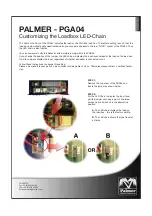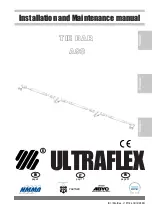
Helix
Ottobock |
43
3.6.3 Possible problem solutions
If the knee joint does not extend during the stance phase after stance phase flexion when used with the
Helix
3D
hip joint, this may be due to a number of different reasons.Therefore, please check the possible causes and, if
applicable, make the specified adaptations to achieve knee joint extension during the stance phase:
C-Leg / Genium: no extension during the stance phase
Cause
Possible solution
The stance phase resistance of the Helix
3D
Hip Joint is
set too high.
Reduce the stance phase resistance (Section 3.6.2).
The stride length, which results from the free swing
range and the swing phase resistance, is set too high.
Increase the swing phase resistance and/or reduce the free
swing range (Section 3.6.2).
The prosthetic alignment is not optimal.
Control and optimisation of the sagittal prosthetic alignment
under load (section 3.4).
Stance phase damping of the knee joint is too low.
The stance phase damping settings of the knee joint should
be optimised for sitting down and for stepoverstep climb
ing and descending of stairs and ramps.
If the CLeg®, in addition, does not switch to the swing phase mode at the end of the stance phase when using
the Helix
3D
Hip Joint, this can have the following causes:
C-Leg® does not switch to the swing phase
Cause
Possible solution
The forefoot load value is not reached during rollover.
Check the forefoot load during walking using CSoft and
correct, if necessary
CSoft Instructions for Use: 647G268).
If the Helix
3D
Hip Joint does not go into extension at heel strike, this can have several causes. Therefore, please
check the following possible causes and, if applicable, make the specified adaptations to achieve extension of
the Helix
3D
Hip Joint at heel strike:
Helix
3D
: no extension at heel strike
Cause
Possible solution
The stance phase resistance of the Helix
3D
Hip Joint is
set too high.
Reduce the stance phase resistance (Section 3.6.2).
The stride length, which results from the free swing
range and the swing phase resistance, is set too high.
Increase the swing phase resistance and/or reduce the free
swing range (Section 3.6.2).
The prosthetic alignment is not optimal.
Control and optimisation of the sagittal prosthetic alignment
under load (section 3.4).
Summary of Contents for Helix3D 7E10
Page 25: ...Helix Ottobock 25...
Page 213: ...Helix Ottobock 213...
Page 259: ...Helix Ottobock 259...
Page 283: ...Helix Ottobock 283...
Page 311: ...Helix Ottobock 311 Ottobock H Ottobock Ottobock H H H Helix3D H...
Page 314: ...314 Ottobock Helix 3 1 1 2 3 4 5 cm 4 5 6 cm 5 A B...
Page 315: ...Helix Ottobock 315 3 2 I 5 2 y y 2 1 1 2 1 3 2 y y 2 4 5...
Page 316: ...316 Ottobock Helix 3 2 1 Helix3D 1 7Z53 1 2 2 1 2 4G576 I 3 2 Helix3D 5 I 4G576 2 5 mm 3 4 5...
Page 318: ...318 Ottobock Helix 3 4 H 1 2 L A S A R Assembly 3 8 2...
Page 319: ...Helix Ottobock 319 30 mm 5 mm 35 mm 1 2 6 3 4 5 0 5 mm...
Page 327: ...Helix Ottobock 327 I Ottobock I ISO 15032 2 3 I Helix3D Ottobock 4 Helix3D 1 2 Helix3D...
Page 329: ...Helix Ottobock 329...
Page 354: ......
Page 355: ......
















































